Research on Morphological Indicator Extraction Method of Pinus massoniana Lamb. Based on 3D Reconstruction
Abstract
:1. Introduction
2. Materials and Methods
2.1. Sample and Experimental Environment
2.2. Camera Calibration
2.3. Acquisition and Preprocessing of Point Cloud
2.3.1. Acquisition of Point Cloud
2.3.2. Point Cloud Denoising
2.3.3. Point Cloud Coordinate Calibration
2.4. Dense Weighted Semantic Segmentation Model Based on PointNet++
2.5. Multi-Iteration Plane Method Based on Laplacian Contraction
2.5.1. Nearest-Neighbor Sorting
2.5.2. Skeleton Refinement of P. massoniana Stem Point Cloud
2.6. Acquisition of Morphological Indicators for P. massoniana Seedlings
2.7. Evaluation Indicators
3. Results and Discussion
3.1. Camera Parameter Matrix
3.2. P. massoniana Point Cloud
3.2.1. Original P. massoniana Seedling Point Cloud
3.2.2. Point Cloud Denoising
3.2.3. Point Cloud Coordinate Calibration
3.2.4. Comparisons with Previous Study
3.3. Dense Weighted Semantic Segmentation Model Based on PointNet++
3.4. Stem Point Cloud Skeleton Extraction
3.5. Other Morphological Indicators of P. massoniana Seedlings
4. Conclusions
- (1)
- For the 3D reconstruction of P. massoniana seedlings, an image acquisition platform was established to capture a multi-angle sequence of 2D images. After distortion correction, the images are used in SFM combined with PMVS to construct a 3D point cloud of P. massoniana seedlings. Preprocessing methods such as denoising and coordinate correction were applied to the original point cloud of P. massoniana.
- (2)
- The processed P. massoniana point cloud was used to create a dataset, and a dense weighted semantic segmentation network based on PointNet++ was proposed to enhance the representation of original features and improve the segmentation accuracy of the input point set. The experimental results demonstrated that the improved PointNet++ network accurately segments the pot, stem, and leaf of P. massoniana. The accuracy of the model on the training and testing sets reached 0.9448 and 0.9430, respectively, indicating its applicability and segmentation performance in point cloud segmentation.
- (3)
- To reduce measurement errors caused by large gaps between neighboring points, a multi-plane iterative method based on Laplacian contraction was employed to refine the skeleton points of the stem point cloud. After skeleton refinement, increased to 0.7191, representing a 20.49% improvement in stem length compared to measurements obtained from the original skeleton points. The predicted parameters of plant height, ground diameter, and height-to-diameter ratio for P. massoniana show good correlation with the ground truth values, with an average determination coefficient of 0.8641.
Author Contributions
Funding
Data Availability Statement
Acknowledgments
Conflicts of Interest
References
- Cloern, J.E.; Abreu, P.C.; Carstensen, J.; Chauvaud, L.; Elmgren, R.; Grall, J.; Greening, H.; Johansson, J.O.R.; Kahru, M.; Sherwood, E.T.; et al. Human activities and climate variability drive fast-paced change across the world’s estuarine-coastal ecosystems. Glob. Chang. Biol. 2016, 22, 513–529. [Google Scholar] [CrossRef] [PubMed]
- Huang, X.; Huang, C.; Teng, M.; Zhou, Z.; Wang, P. Net Primary Productivity of Pinus massoniana Dependence on Climate, Soil and Forest Characteristics. Forests 2020, 11, 404. [Google Scholar] [CrossRef]
- You, Y.; Huang, X.; Zhu, H.; Liu, S.; Liang, H.; Wen, Y.; Wang, H.; Cai, D.; Ye, D. Positive interactions between Pinus massoniana and Castanopsis hystrix species in the uneven-aged mixed plantations can produce more ecosystem carbon in subtropical China. For. Ecol. Manag. 2018, 410, 193–200. [Google Scholar] [CrossRef]
- Tian, M.F.; Zhang, B.G.; Wu, Z.G.; Yu, L.P.; Li, L.F.; Xi, X.D. Effects of Steam Heat-Treatment on Properties of Pinus massoniana Wood and Its Bonding Performance. J. Renew. Mater. 2021, 9, 789–801. [Google Scholar] [CrossRef]
- Zhang, S.; Gu, X.; Zhao, X.; Zhu, J.; Zhao, Y. Influences of Climatic Factors and Human Activities on Forest–Shrub–Grass Suitability in the Yellow River Basin, China. Forests 2023, 14, 1198. [Google Scholar] [CrossRef]
- Harayama, H.; Tsuyama, I.; Kitao, M.; Yamada, T.; Furuya, N.; Utsugi, H.; Sasaki, S. Effects of Seedling Size, Stock Type, and Mechanical Site Preparation Method on Initial Survival and Growth of Japanese Larch (Larix kaempferi) Seedlings. Forests 2023, 14, 784. [Google Scholar] [CrossRef]
- Grossnickle, S.C.; MacDonald, J.E. Seedling Quality: History, Application, and Plant Attributes. Forests 2018, 9, 283. [Google Scholar]
- Hou, J. Effect of seedling grade standard on improving the quality of licorice (Glycyrrhiza uralensis F.): Changes in the seven bioactive components and root biomass during two-year growth. Food Sci. Biotechnol. 2018, 27, 1245. [Google Scholar] [CrossRef]
- Cho, S.; Kim, T.; Jung, D.H.; Park, S.H.; Na, Y.; Ihn, Y.S.; Kim, K. Plant growth information measurement based on object detection and image fusion using a smart farm robot. Comput. Electron. Agric. 2023, 207, 107703. [Google Scholar] [CrossRef]
- Lati, R.N.; Filin, S.; Eizenberg, H. Estimation of Plants’ Growth Parameters via Image-Based Reconstruction of Their Three-Dimensional Shape. Agron. J. 2013, 105, 191–198. [Google Scholar] [CrossRef]
- Nasir, A.K.; Taj, M.; Khan, M.F. Evaluation of Microsoft Kinect Sensor for Plant Health Monitoring. In Proceedings of the 5th IFAC Conference on Sensing, Control and Automation Technologies for Agriculture (AGRICONTROL), Seattle, WA, USA, 14–17 August 2016; pp. 221–225. [Google Scholar]
- Qiu, R.C.; Wei, S.; Zhang, M.; Li, H.; Sun, H.; Liu, G.; Li, M.Z. Sensors for measuring plant phenotyping: A review. Int. J. Agric. Biol. Eng. 2018, 11, 1–17. [Google Scholar] [CrossRef]
- Gibbs, J.A.; Pound, M.; French, A.P.; Wells, D.M.; Murchie, E.; Pridmore, T. Approaches to three-dimensional reconstruction of plant shoot topology and geometry. J. Funct. Plant Biol. 2017, 44, 62–75. [Google Scholar] [CrossRef]
- Grift, T.E.; Oberti, R. Development of low-cost, root collar diameter measurement devices for pine seedlings. Comput. Electron. Agric. 2006, 52, 60–70. [Google Scholar] [CrossRef]
- McGuinness, B.; Duke, M.; Au, C.K.; Lim, S.H. Measuring radiata pine seedling morphological features using a machine vision system. Comput. Electron. Agric. 2021, 189, 106355. [Google Scholar] [CrossRef]
- Suo, R.; Fu, L.S.; He, L.L.; Li, G.; Majeed, Y.; Liu, X.J.; Zhao, G.A.; Yang, R.Z.; Li, R. A novel labeling strategy to improve apple seedling segmentation using BlendMask for online grading. Comput. Electron. Agric. 2022, 201, 107333. [Google Scholar] [CrossRef]
- Hao, Z.B.; Lin, L.L.; Post, C.J.; Mikhailova, E.A.; Li, M.H.; Yu, K.Y.; Liu, J.; Chen, Y. Automated tree-crown and height detection in a young forest plantation using mask region-based convolutional neural network (Mask R-CNN). ISPRS J. Photogramm. Remote Sens. 2021, 178, 112–123. [Google Scholar] [CrossRef]
- Sun, X.M.; Fang, W.T.; Gao, C.Q.; Fu, L.S.; Majeed, Y.; Liu, X.J.; Gao, F.F.; Yang, R.Z.; Li, R. Remote estimation of grafted apple tree trunk diameter in modern orchard with RGB and point cloud based on SOLOv2. Comput. Electron. Agric. 2022, 199, 107209. [Google Scholar] [CrossRef]
- Zhang, H.C.; Ge, Y.F.; Xie, X.Y.; Atefi, A.; Wijewardane, N.K.; Thapa, S. High throughput analysis of leaf chlorophyll content in sorghum using RGB, hyperspectral, and fluorescence imaging and sensor fusion. Plant Methods 2022, 18, 60. [Google Scholar] [CrossRef]
- Li, X.; Pan, J.D.; Xie, F.P.; Zeng, J.P.; Li, Q.; Huang, X.J.; Liu, D.W.; Wang, X.S. Fast and accurate green pepper detection in complex backgrounds via an improved Yolov4-tiny model. Comput. Electron. Agric. 2021, 191, 106503. [Google Scholar] [CrossRef]
- Kolhar, S.; Jagtap, J. Convolutional neural network based encoder-decoder architectures for semantic segmentation of plants. Ecol. Inform. 2021, 64, 101373. [Google Scholar] [CrossRef]
- Tang, H.; Zhu, H.Y.; Fei, L.F.; Wang, T.W.; Cao, Y.C.; Xie, C. Low-Illumination Image Enhancement Based on Deep Learning Techniques: A Brief Review. Photonics 2023, 10, 198. [Google Scholar] [CrossRef]
- Jin, X.J.; Che, J.; Chen, Y. Weed Identification Using Deep Learning and Image Processing in Vegetable Plantation. IEEE Access 2021, 9, 10940–10950. [Google Scholar] [CrossRef]
- Li, Q.; Xue, Y. Real-time detection of street tree crowns using mobile laser scanning based on pointwise classification. Biosyst. Eng. 2023, 231, 20–35. [Google Scholar] [CrossRef]
- Zou, H.Y.; Sun, X.Y. 3D Face Recognition Based on an Attention Mechanism and Sparse Loss Function. Electronics 2021, 10, 2539. [Google Scholar] [CrossRef]
- Mirande, K.; Godin, C.; Tisserand, M.; Charlaix, J.; Besnard, F.; Hetroy-Wheeler, F. A graph-based approach for simultaneous semantic and instance segmentation of plant 3D point clouds. Front. Plant Sci. 2022, 13, 1012669. [Google Scholar] [CrossRef]
- Giang, T.T.H.; Ryoo, Y.J. Pruning Points Detection of Sweet Pepper Plants Using 3D Point Clouds and Semantic Segmentation Neural Network. Sensors 2023, 23, 4040. [Google Scholar] [CrossRef]
- Sun, G.X.; Wang, X.C. Three-Dimensional Point Cloud Reconstruction and Morphology Measurement Method for Greenhouse Plants Based on the Kinect Sensor Self-Calibration. Agronomy 2019, 9, 596. [Google Scholar] [CrossRef]
- Turgut, K.; Dutagaci, H.; Galopin, G.; Rousseau, D. Segmentation of structural parts of rosebush plants with 3D point-based deep learning methods. Plant Methods 2022, 18, 20. [Google Scholar] [CrossRef]
- Qi, C.R.; Yi, L.; Su, H.; Guibas, L.J. PointNet plus plus: Deep Hierarchical Feature Learning on Point Sets in a Metric Space. In Proceedings of the 31st Annual Conference on Neural Information Processing Systems (NIPS), Long Beach, CA, USA, 4–9 December 2017. [Google Scholar]
- Lhuillier, M.; Quan, L. Match propagation for image-based modeling and rendering. IEEE Trans. Pattern Anal. Mach. Intell. 2002, 24, 1140–1146. [Google Scholar] [CrossRef]
- Vogiatzis, G.; Hernandez, C. Video-based, real-time multi-view stereo. Image Vis. Comput. 2011, 29, 434–441. [Google Scholar] [CrossRef]
- Zhang, Z. A Flexible New Technique for Camera Calibration. IEEE Trans. Pattern Anal. Mach. Intell. 2000, 22, 1330–1334. [Google Scholar] [CrossRef]
- Zhao, F.Q. Point cloud denoising algorithm with geometric feature preserving. Multimed. Syst. 2022, 28, 1679–1687. [Google Scholar] [CrossRef]
- Qi, C.R.; Su, H.; Mo, K.C.; Guibas, L.J. PointNet: Deep Learning on Point Sets for 3D Classification and Segmentation. In Proceedings of the 30th IEEE/CVF Conference on Computer Vision and Pattern Recognition (CVPR), Honolulu, HI, USA, 21–26 July 2017; pp. 77–85. [Google Scholar]
- Li, Y.R.; Liu, Y.; Wang, L. Study on static index detection method of masson pine seedlings based on multi-information fusion. J. For. Eng. 2019, 4, 129–133. [Google Scholar] [CrossRef]
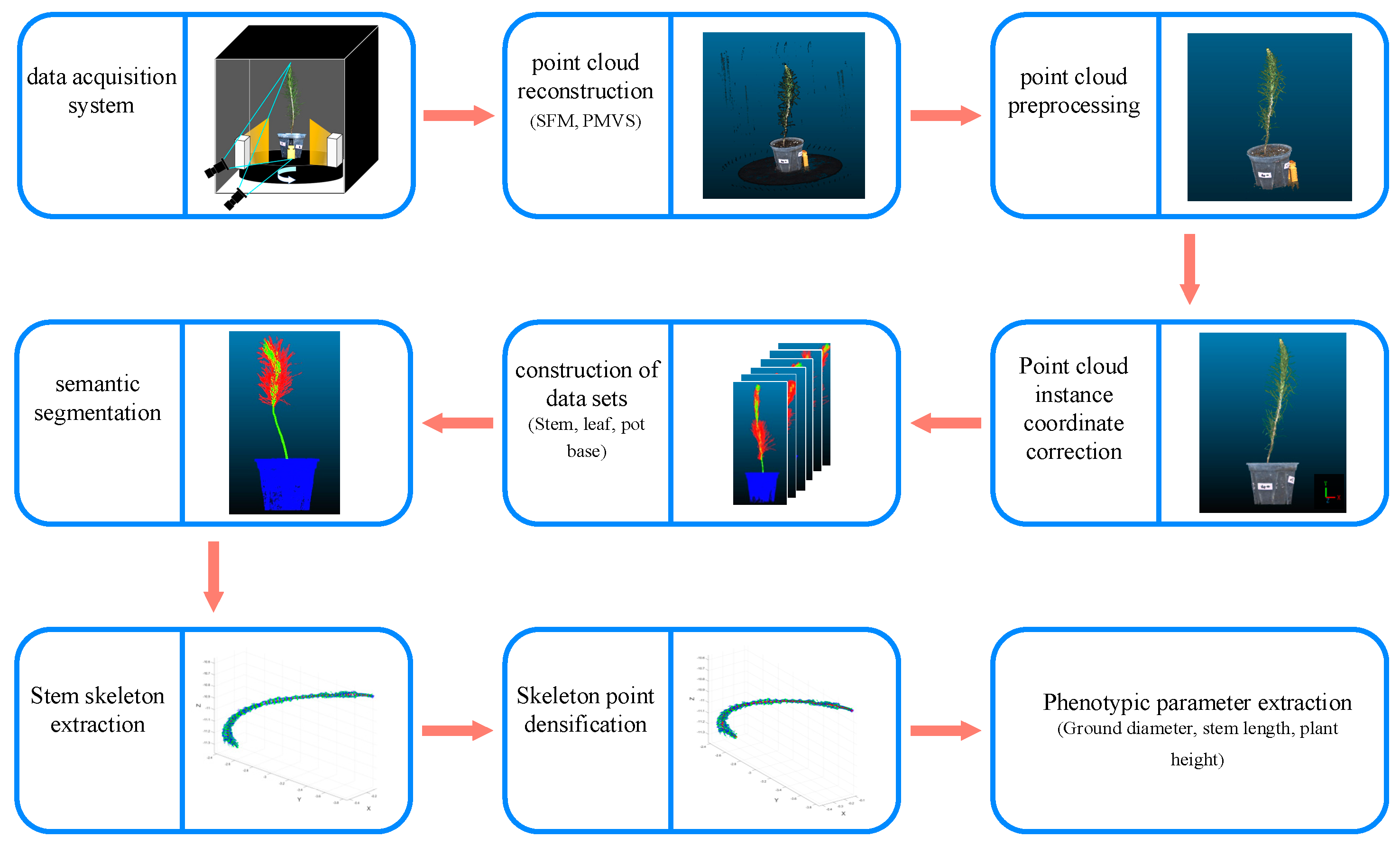
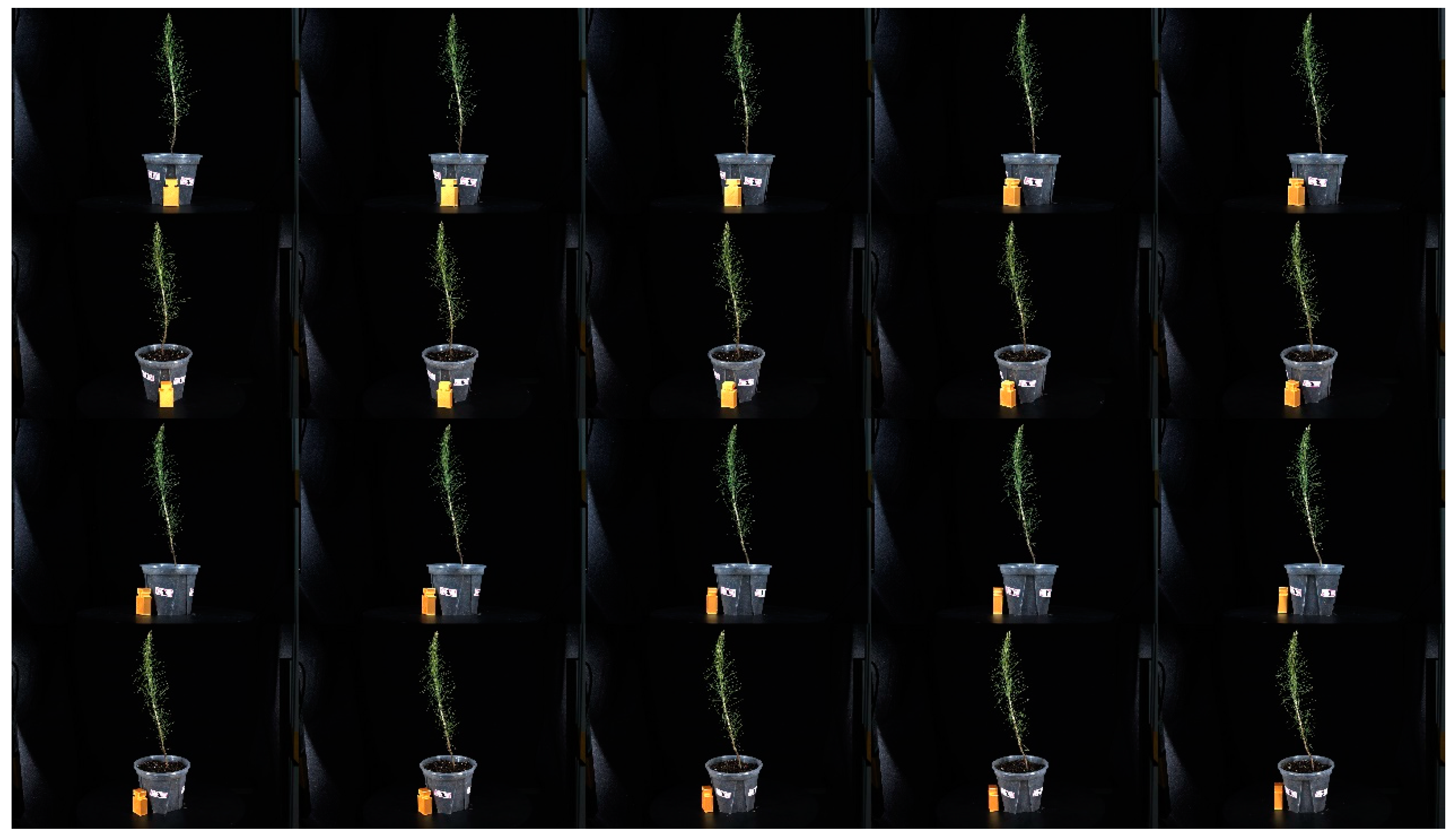

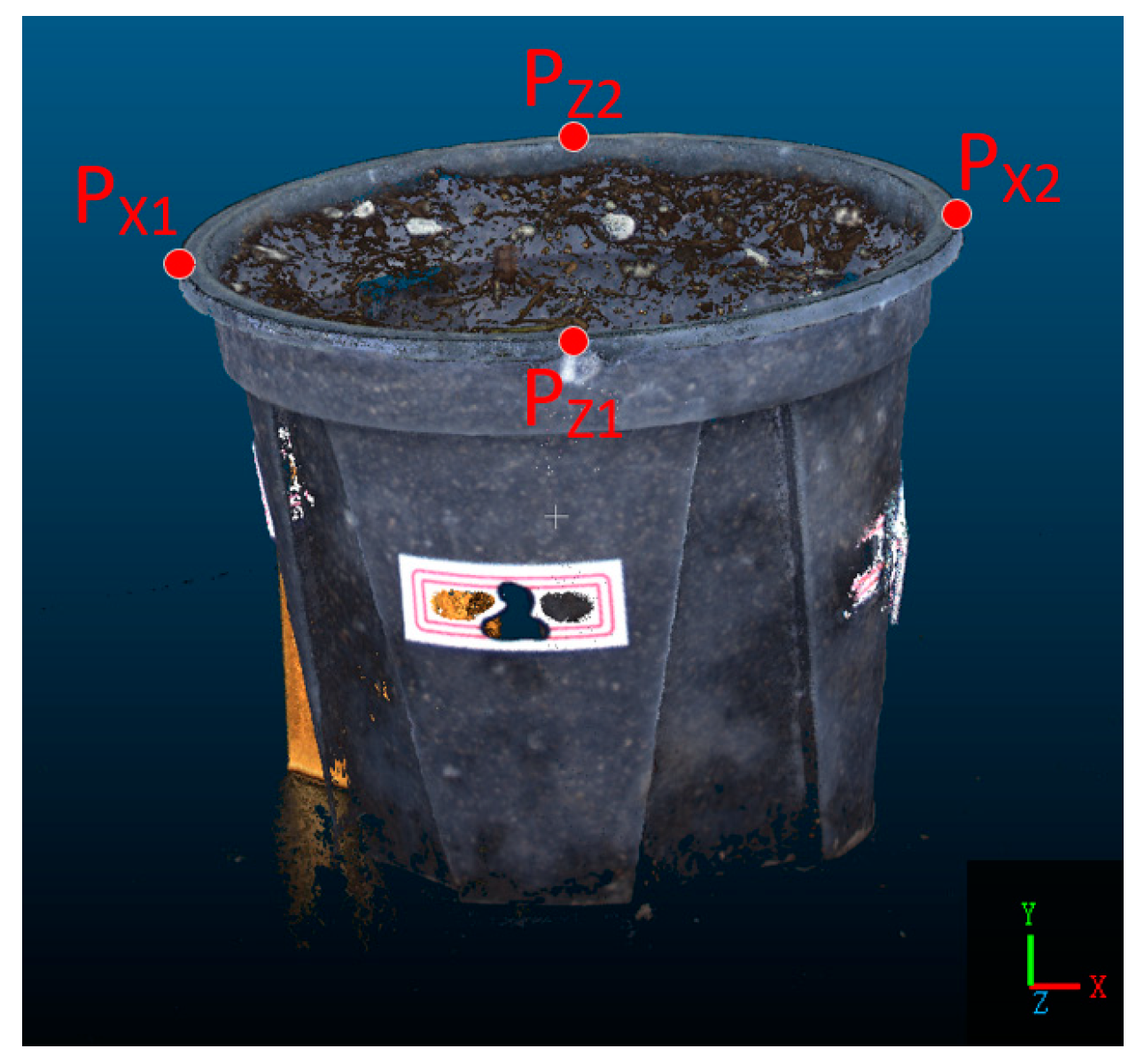

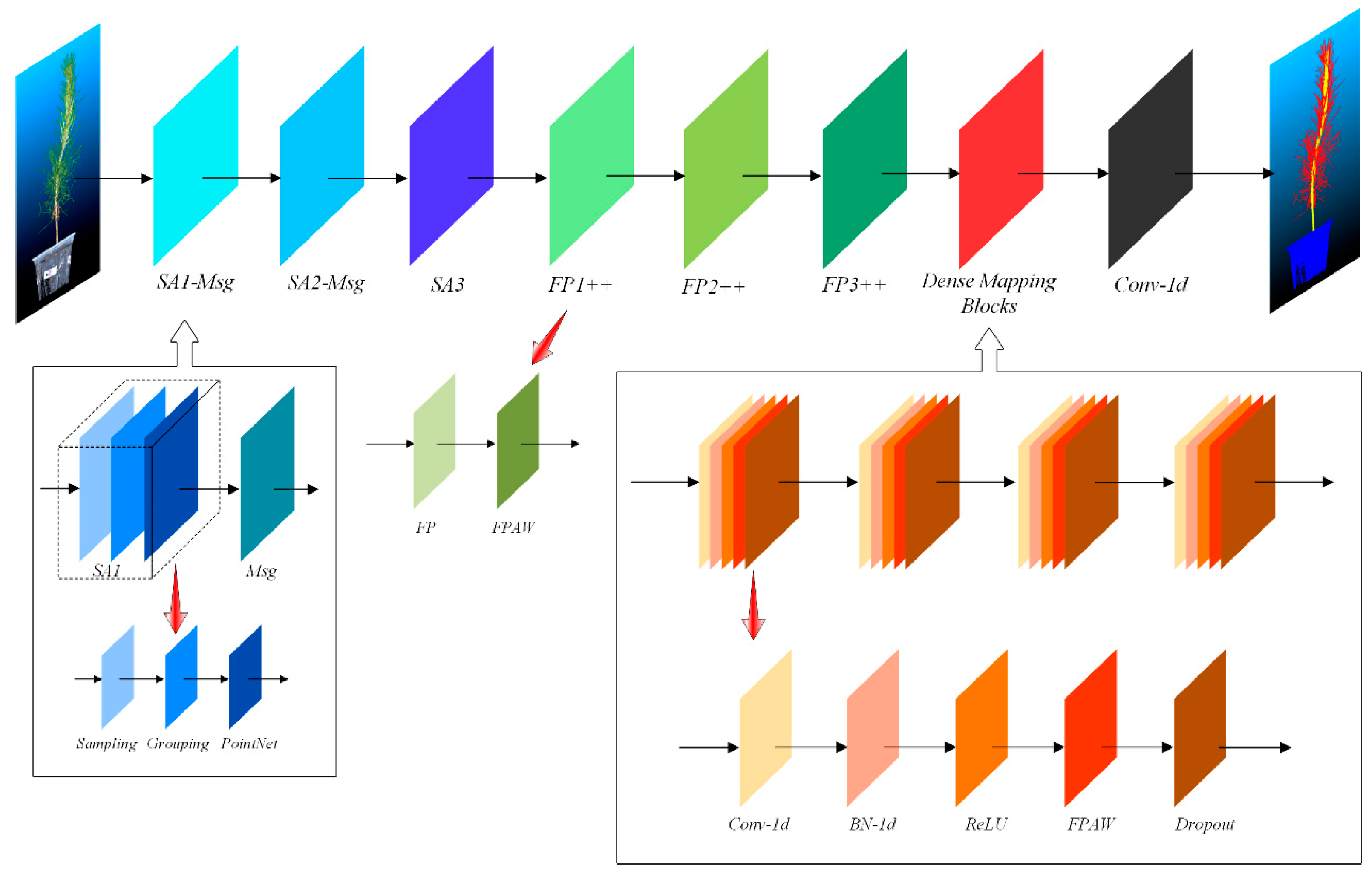

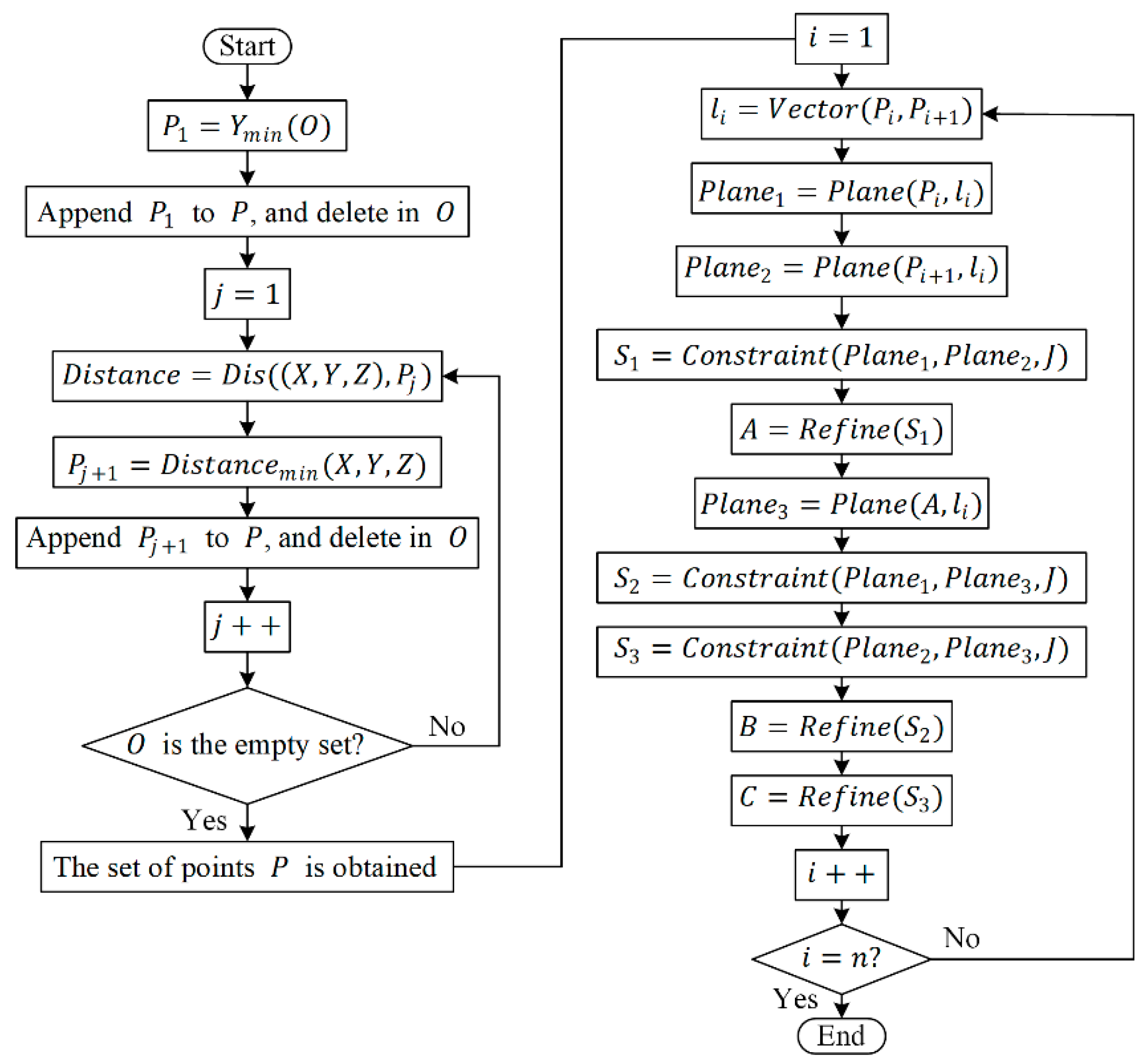
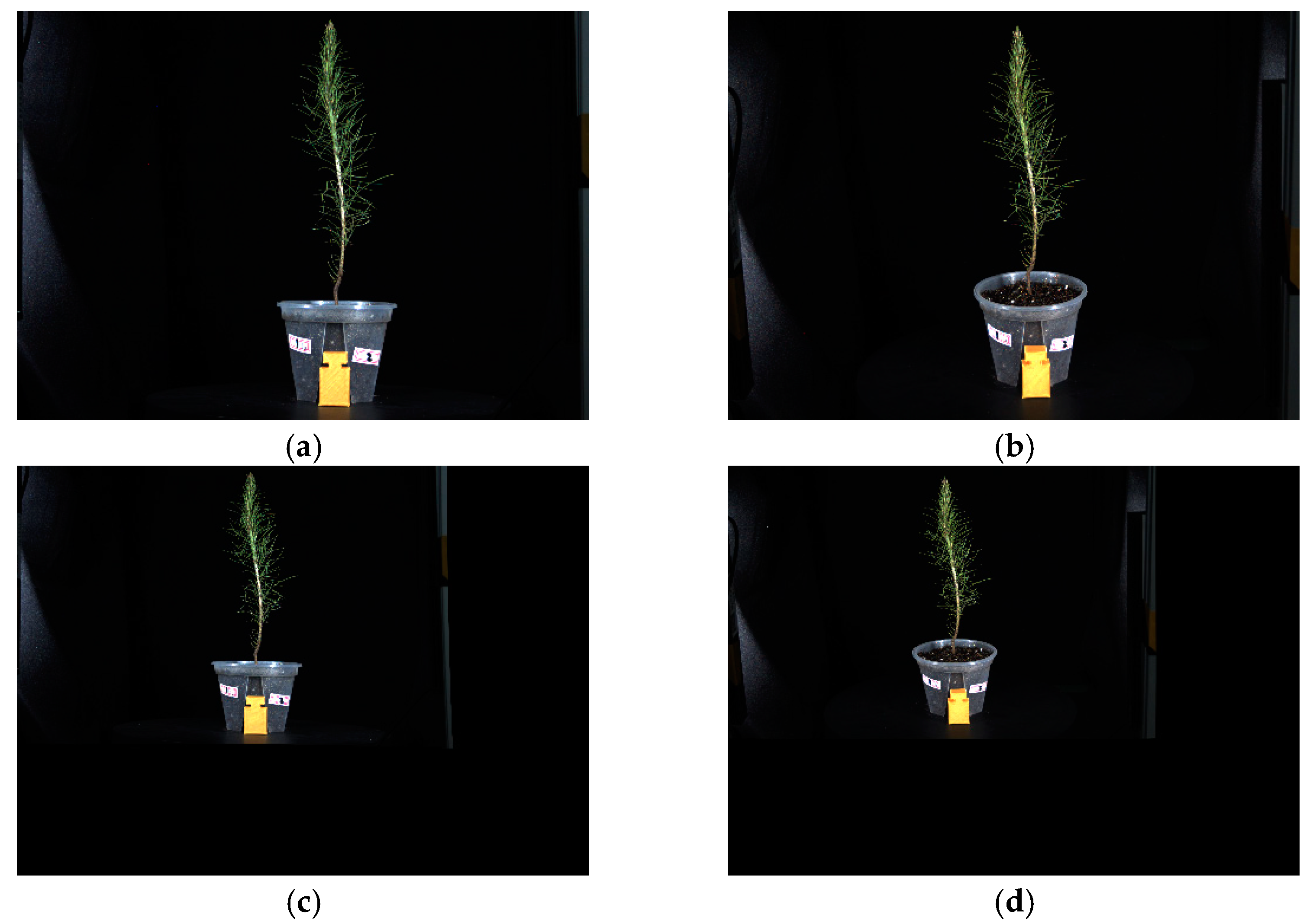
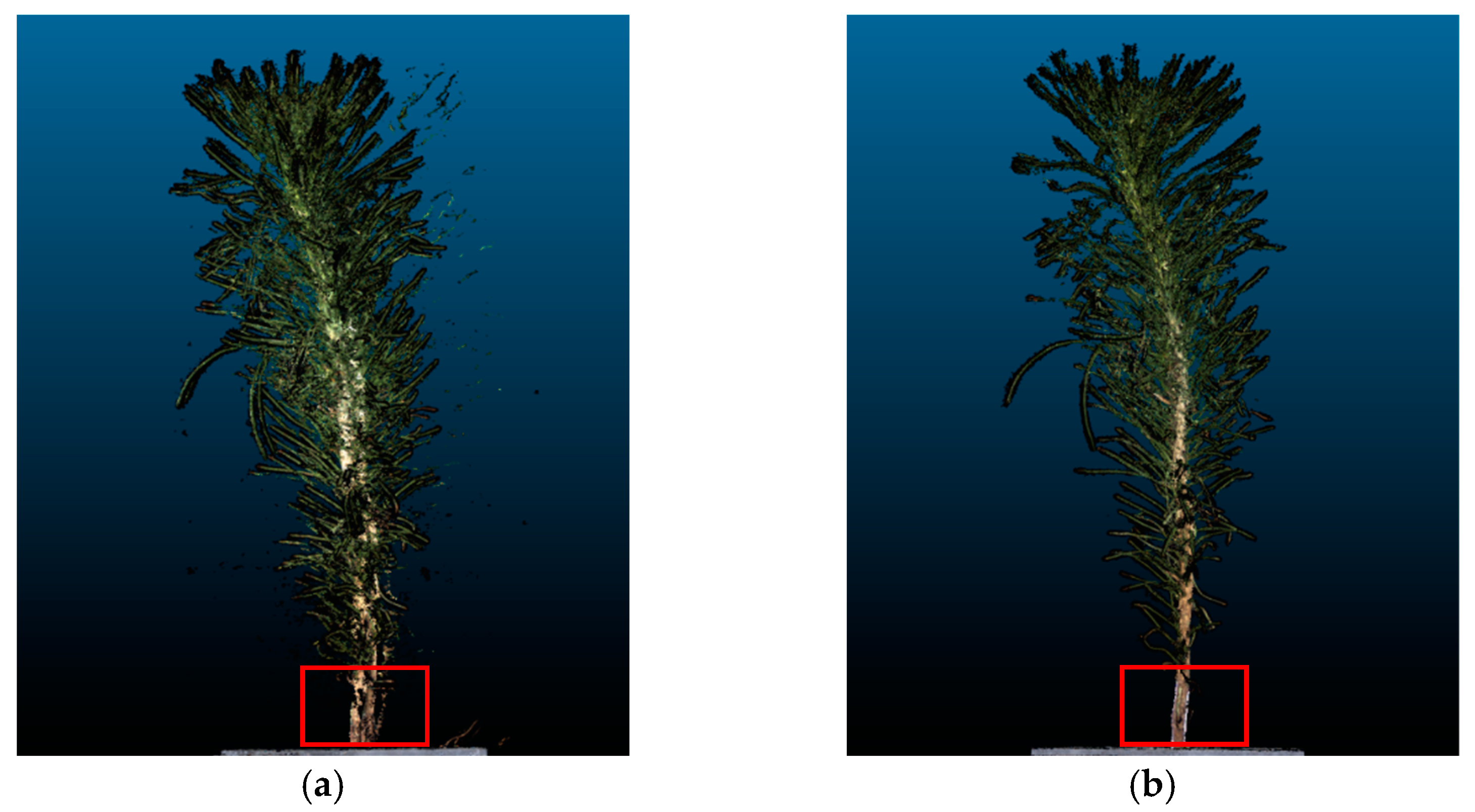


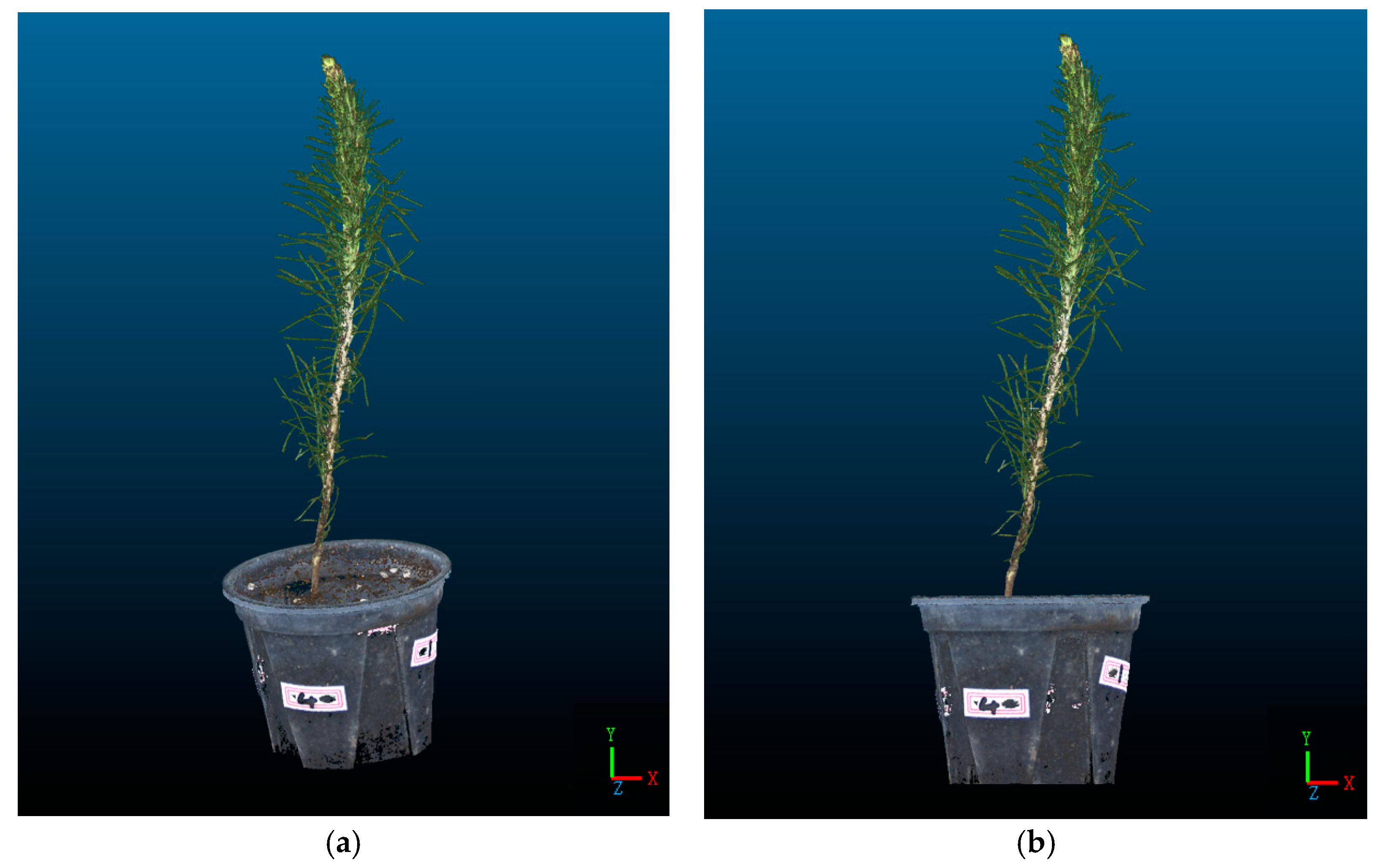

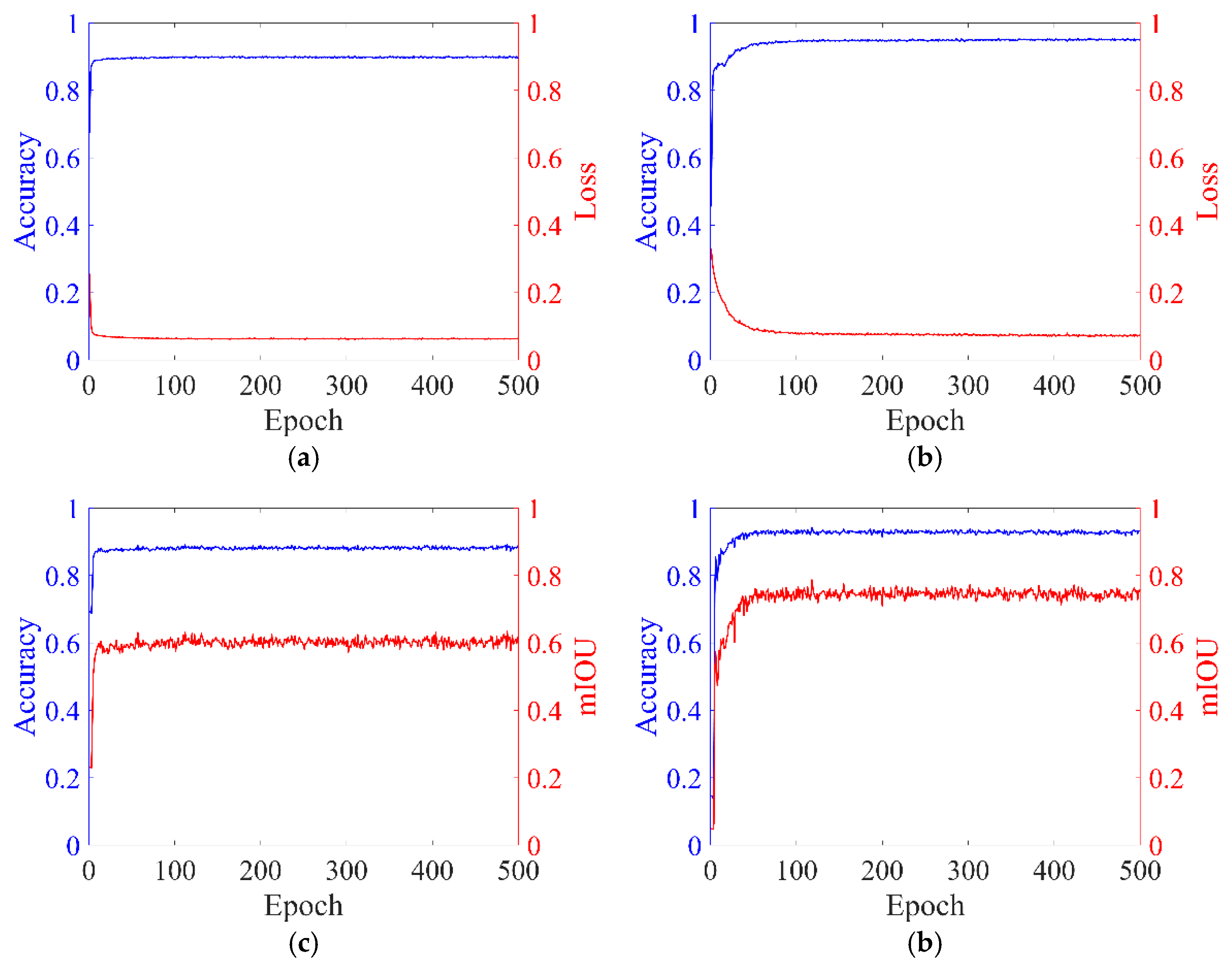
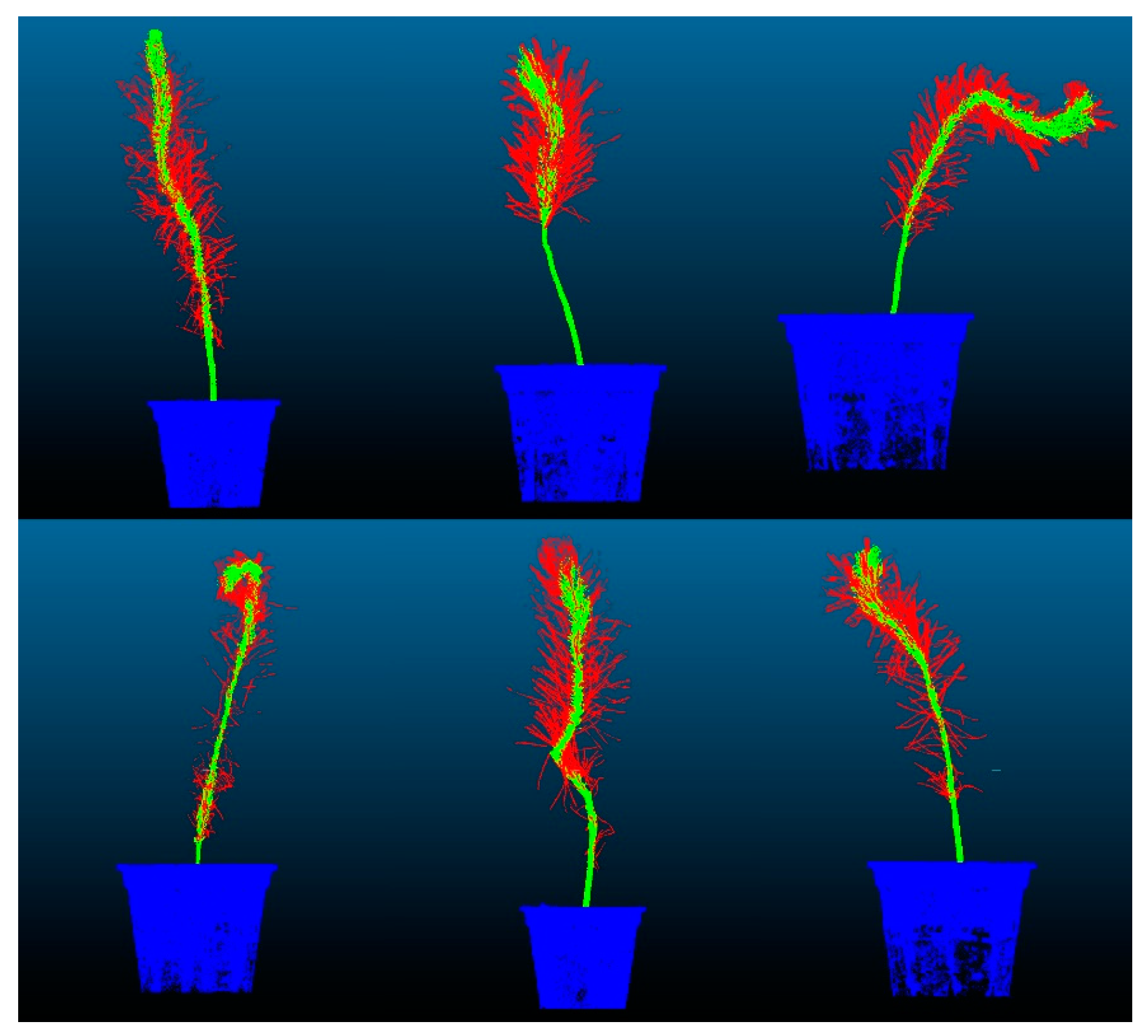
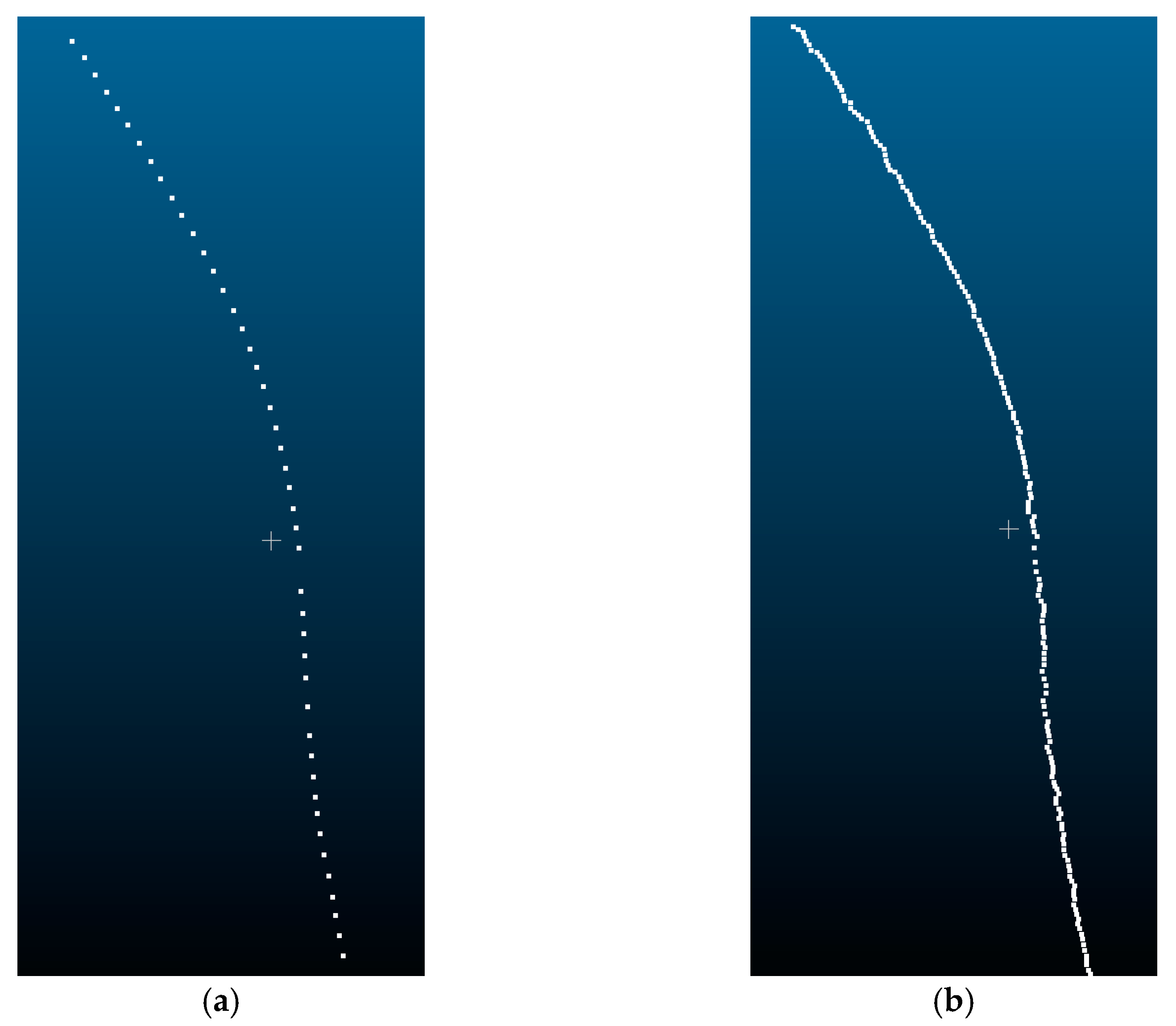

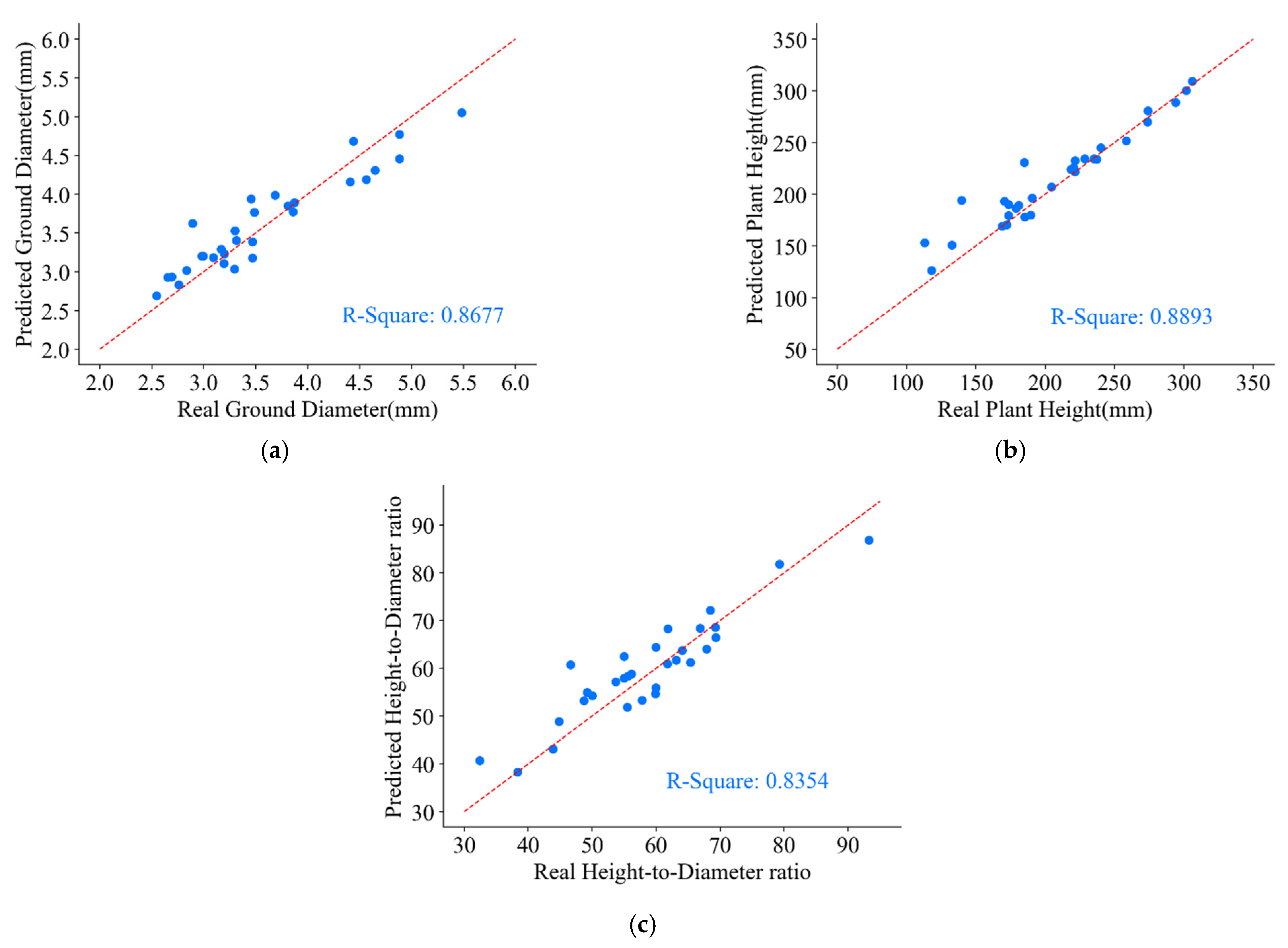
| Name | Parameter | |
|---|---|---|
| MER-1070-10GC | Resolution | 3840 × 2748 px |
| Frame rate | 10 fps | |
| Sensor | 1/2.3″ MT9J003 electronic Rolling shutter CMOS | |
| Signal-to-noise ratio | 36.67 dB | |
| M1620-MPW2 | Focal length | 16 mm |
| Iris | F2.0–F16.0 |
| Camera | Intrinsic Matrix | Radial Distortion Coefficient | Average Reprojection Error | Resolution |
|---|---|---|---|---|
| Front-view camera | 0.3071 | 3840 × 2748 | ||
| Oblique-view camera | 0.1277 | 3840 × 2748 |
| Model | Training Set | Test Set | ||
|---|---|---|---|---|
| Accuracy | Loss | Accuracy | mIOU | |
| PointNet++ | 0.8966 | 0.1444 | 0.8915 | 0.6361 |
| CDC-PointNet++ (our algorithm) | 0.9448 | 0.0814 | 0.9430 | 0.7872 |
Disclaimer/Publisher’s Note: The statements, opinions and data contained in all publications are solely those of the individual author(s) and contributor(s) and not of MDPI and/or the editor(s). MDPI and/or the editor(s) disclaim responsibility for any injury to people or property resulting from any ideas, methods, instructions or products referred to in the content. |
© 2023 by the authors. Licensee MDPI, Basel, Switzerland. This article is an open access article distributed under the terms and conditions of the Creative Commons Attribution (CC BY) license (https://creativecommons.org/licenses/by/4.0/).
Share and Cite
Li, Y.; Xia, H.; Liu, Y.; Ji, K.; Huo, L.; Ni, C. Research on Morphological Indicator Extraction Method of Pinus massoniana Lamb. Based on 3D Reconstruction. Forests 2023, 14, 1726. https://doi.org/10.3390/f14091726
Li Y, Xia H, Liu Y, Ji K, Huo L, Ni C. Research on Morphological Indicator Extraction Method of Pinus massoniana Lamb. Based on 3D Reconstruction. Forests. 2023; 14(9):1726. https://doi.org/10.3390/f14091726
Chicago/Turabian StyleLi, Yurong, Haifei Xia, Ying Liu, Kaihao Ji, Lintao Huo, and Chao Ni. 2023. "Research on Morphological Indicator Extraction Method of Pinus massoniana Lamb. Based on 3D Reconstruction" Forests 14, no. 9: 1726. https://doi.org/10.3390/f14091726






